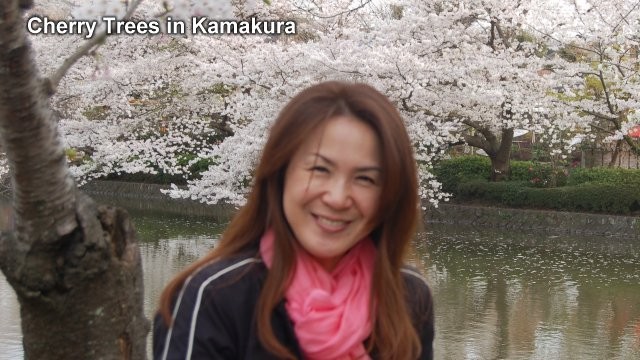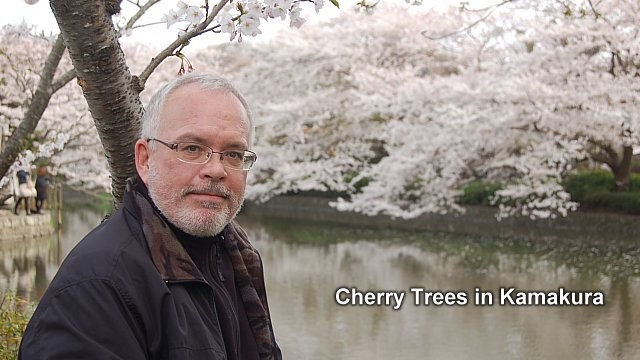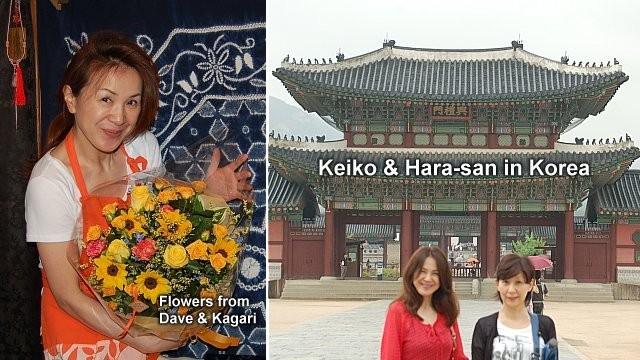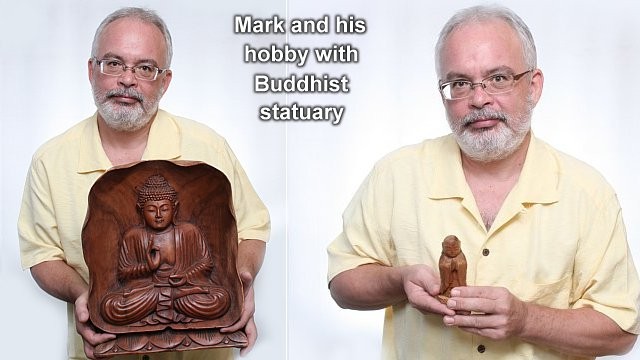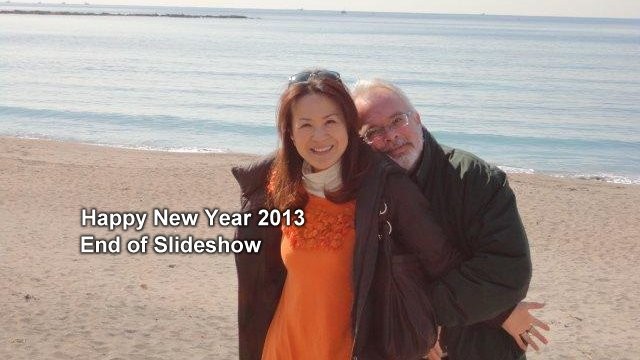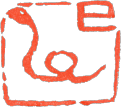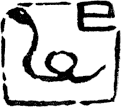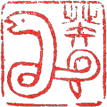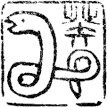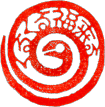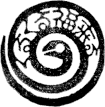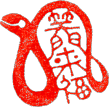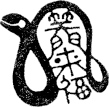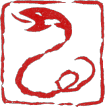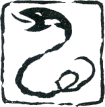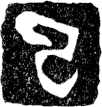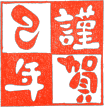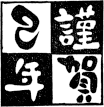|
THE SNAKE. In both China and Japan, a common symbol for longevity is a snake embracing a tortoise (see photo), for Chinese mythology says their union engendered the universe (there were no male tortoises -- as the ancients believed --- so the female had to mate with a snake). In Chinese artwork, the tortoise-snake pairing dates back to the third century AD. In China’s Yin-Yang traditions, the snake (yang) is a symbol of dynamic potency, while the turtle (yin) is a symbol of stillness and endurance. In Japan, the serpent is more closely linked to the dragon than the turtle. In Japanese lore, snakes and dragons are both serpentine creatures, both are closely associated with water and treasure, both are depicted holding wish-granting jewels, and both are avatars of Benzaiten, the Japanese goddess of water, wealth, and good fortune. In Japan, the snake is also closely linked to the rice crop. See adjacent column or learn more at the A-to-Z Photo Dictionary of Japanese Buddhism and Shintoism.
|
SNAKE LORE IN JAPAN. Japan’s most revered serpent is Ugajin 宇賀神. This kami (deity) is associated closely with water and rice and hence considered a god of wealth and prosperity. In artwork, Ugajin appears commonly as a coiled white snake with the head of an old man. In Japan’s Heian era (794-1185 CE), Ugajin was merged with the water goddess Benzaiten (one of modern Japan’s most popular deities) to create the combinatory kami Uga Benzaiten. Although Ugajin’s origins are elusive and complex, most scholars believe Ugajin was derived from Uga no Mitama -- a food deity, the spirit of rice, a kami who appeared in Japan’s oldest extant written record (712 CE). Now jump forward at warp speed. Keiko and I live in Kamakura. The city’s second most-visited site is Zeniarai Benzaiten Ugafuku Shrine, popularly known as the “Money Washing Shrine.” People believe that washing their coins and paper money in water from the shrine's sacred mountain stream will bring them financial success by "making their money multiple." According to the shrine, the founder of the Kamakura era (Minamoto Yoritomo, 1147-1199 CE) had a dream in 1185 on the day of the snake in the month of the snake in the year of the snake (a very auspicious day in the Zodiacal calendar). In the dream, an old man named Ugafukujin (Lucky God Uga) appeared and told Minamoto about a sacred spring of pure water in the Kamakura area. He told Minamoto to build a shrine at this location and dedicate it to Ugafukujin (aka Ugajin). If he did so, peace and prosperity would come to the country. Minamoto promptly built a shrine on the spot, and farmers came to pray to Ugafukujin for a bumper crop by washing their rice seeds in the sacred water. Today people come here to wash their money. The shrine is especially popular on days of the snake, when the money-expanding wealth-expanding powers of Ugafukujin are said to be most effective. Locals say putting a cast-off snake skin in your wallet will bring wealth.
|
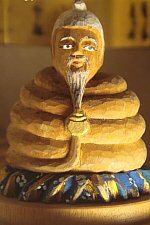
Ugajin
Snake body, human head.
Photograph from museum
Musee Guimet (France).
No date given.
|
|
JAPANESE VOTIVE TABLETS. Known as EMA 絵馬, such tablets can be purchased at most shrines (less so at temples). You write your name and petition on the back, and then hang the tablet inside the shrine compound in the hope the kami (deity) will answer your prayer.
|
|
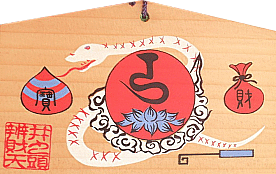
|
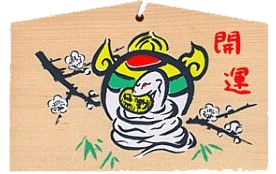
|
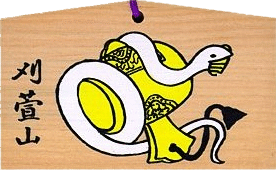
|
|
Votive Snake Tablet, Modern, at Inokashira Benten Hall 井の頭弁財天本堂, Tokyo. A stone statue of Ugajin (the snake kami; see earlier text) is located near the hall. This votive tablet depicts Ugajin as a white snake. The character 寶 (treasure of buddha-nature) is drawn inside a wish-granting jewel, and the character 財 (meaning wealth) drawn inside a money bag. The key to the storehouse is shown at bottom. Sanskrit seed at center read U, for Ugajin. Photo this J-site.
|
Votive Snake Tablet, Modern, at Murayama Sengen Jinja 村山浅間神社 (Shizuoka). The above tablet shows a white snake (with a gold coin in its mouth) surrounded by the sacred wish-granting jewel. The wish-granting jewel is said to miraculously produce anything desired for devout followers. Thus, the theme of this tablet is wealth and the granting of wishes. The red characters are pronounced Kaiun 開運, which mean "Open to Luck, Fortune, & Prosperity." Photo this J-site.
|
Votive Snake Tablet, Modern, at Karikayadō 刈萱堂 (near Zenkōji Temple in Nagano City). The above tablet shows a white snake (with gold in its mouth) curled around Daikokuten's magic mallet. Daikoku is one of Japan’s Seven Lucky Gods. This mallet is said to miraculously produce anything desired when struck. Some say coins fall out when Daikokuten shakes it. The tablet's theme is prosperity -- the white snake and golden mallet represent the treasures of rice and agriculture, hence wealth. Photo this J-site.
|
|
|
|
SNAKE IN CHINESE, JAPANESE, AND TIBETAN TRADITIONS
|
|
CHINA
|
JAPAN
|
TIBET
|
|
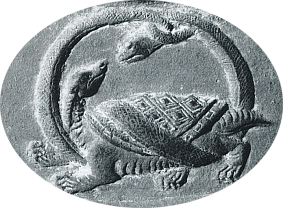
|
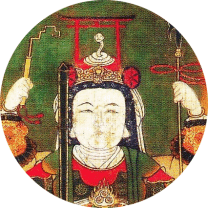
|
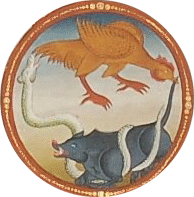
|
|
Snake embracing turtle. Closeup, bronze mirror, 8th century CE, in collection of Shōsō-in (Nara, Japan). In China, a common symbol for longevity is a snake embracing a tortoise. Chinese myth says their union created the universe (since there were no male tortoises, the female had to mate with a snake). In Chinese art, the turtle-snake pairing dates back to the third century AD. Above photo comes from the “63rd Annual Exhibition of Shōsō-in Treasures (2011).” The mirror includes images of the four animals of the compass directions and others.
|
Uga Benzaiten. Closeup, hanging scroll, last half of 15th century CE. In Japan’s late Heian era (794-1185 CE), the human-headed snake-bodied Ugajin was merged with the water goddess Benzaiten, one of modern Japan’s most popular deities, to create the combinatory kami Uga Benzaiten (identified by the snake & shrine gate atop her head). This deity -- even today -- is worshiped for good fortune, agricultural blessings, and ample rain. H = 97 cm, W = 40.5 cm. Photo scanned from Catherine Ludvik's article in Impressions, #33, 2012, p. 105).
|
Modern Tanka. At the center of many Tibetan Tanka (Tibetan Wheel of Life paintings) one commonly finds three animals -- a pig, a snake, and a rooster. The pig symbolizes greed (Skt. = lobha), the snake anger and hatred (Skt. = dosa), and the rooster (or cock) ignorance or delusion (Skt. = moha). The three animals are often shown biting each others tails, to show that these evils are inseparably connected. The emotions of the three stem from fundamental ignorance. Together, the triad represents the root causes of trouble on earth. Photo Schumacher.
|
|
|






